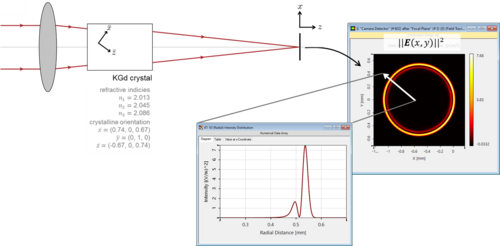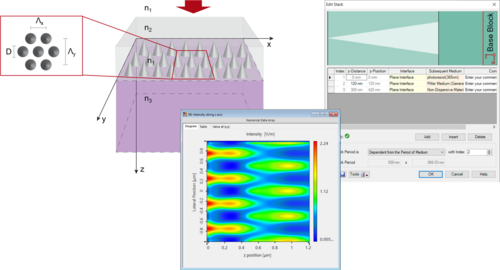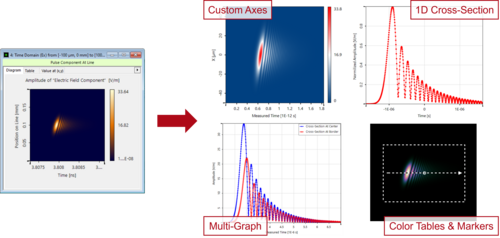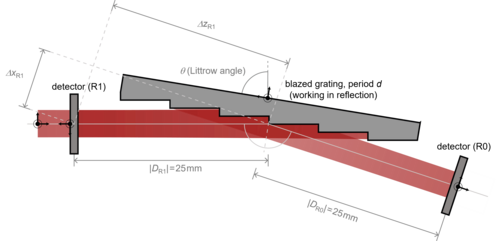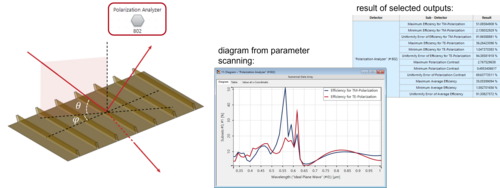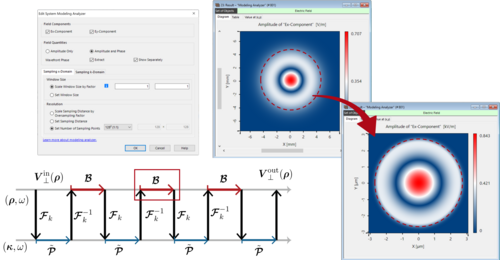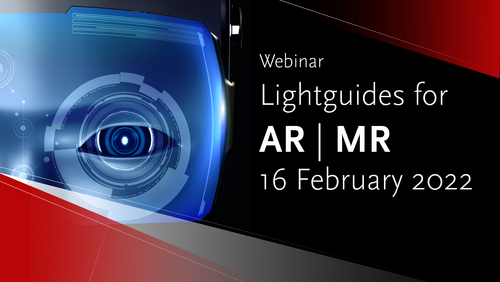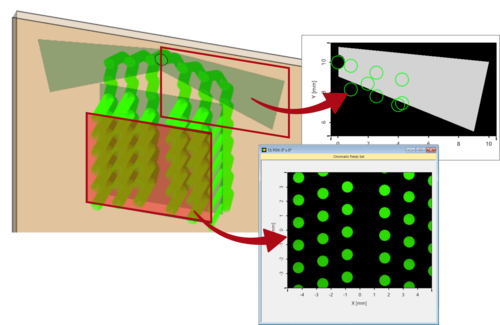What’s new?
Modeling and Application of Conical Refraction in Biaxial Crystals
Conical refraction is a well-known phenomenon caused by optical anisotropy. It occurs when a convergent beam propagates through a biaxial crystal along one of its optic axes: the transmitted field evolves into a cone that is highly dependent on the polarization state of the input beam. Several applications have been developed based on this phenomenon; using it as the basis for polarization metrology is one of the most interesting.
With the fast physical optics modeling and design software VirtualLab Fusion, this effect and its applications can be fully investigated. Take a look at the examples below, where we first demonstrate the basic principles of conical refraction with a circularly polarized input beam, and then analyze the design of a polarimeter with two biaxial crystals in separated arms.
Read moreModeling and Application of the Talbot Effect
In diffractive optics, when a periodic structure is illuminated by collimated light, it is possible to observe the image of the periodic structure forming at periodic distances behind the object. This is the well-known Talbot effect (with the so-called Talbot distance describing the periodic intervals) which has seen regular application in e.g. lithography.
With the Field Tracing technology of the fast physical optics modeling and design software VirtualLab Fusion, this effect and its applications can be fully investigated. See the examples below, where we demonstrate the basic principles of the Talbot effect with linear and crossed patterns, and have a closer look at a particular lithography application to produce nanostructures.
Read moreFormat & Customization of Simulation Results
While providing handy tools to enable the user to obtain fast and accurate results for a desired optical task is the main purpose of any optical simulation software, the value of a versatile post processing capabilities should not be underestimated. The customization of the appearance of the resulting data enables to either fit specific requirements for a publication in a journal or kind of reports, but moreover to emphasize and highlight interesting and crucial aspects of the results.
In the selected Use Cases, different options for the customization of detector results and the appearance of VirtualLab Fusion in general are presented.
Read moreConfiguration and Optimization of Grating Systems in Littrow Configuration
"Littrow configuration” is the name given to those optical systems containing a reflective grating in which the orientation of the grating is such that the working order (most often the first diffraction order) travels back along the direction of the incident beam. This can be useful for various different applications, for example, in the context of laser resonators, where the grating can act as one of the mirrors of the resonator, or in monochromators and spectrometers.
In this week’s newsletter, we present two examples related to gratings in Littrow configuration. In the first, we demonstrate how to employ the Parameter Coupling tool in VirtualLab Fusion to ensure that the Littrow condition is fulfilled, by automatically adjusting the orientation of the grating, and the orientation and position of the detectors according to the wavelength and grating period. In the second example, we go over the optimization of a grating intended for use under Littrow configuration, where the goal is to design the grating structure so as to minimize its polarization effects.
Read morePolarization Analysis of Gratings
Gratings are a fundamental component of many classical and modern optical systems, like those in the field of spectrometry or near-eye displays. A characteristic feature of gratings is their sensitivity to the polarization state of the incoming light, and their strongly vectorial behavior in general.
Regardless of whether this effect is desired or detrimental, the fast physical optics software VirtualLab Fusion has got you covered: First of all, through its consistent vectorial treatment, not only of the field and the grating itself, but of the whole optical system which the grating may be a part of. Second, because VirtualLab Fusion offers the necessary tools to analyze in detail the vectorial behavior of your gratings.
In the examples below, we show an in-depth introduction of the
Polarization Analyzer – a powerful tool in the Grating Optical Setup that allows the user to calculate the efficiencies of grating orders with respect to different polarization states, with additional options to study the role of the wavelength and angle of incidence – and an investigation of the polarization effects of slanted gratings.
System Modeling in K- and X-Domain
For an accurate and fast simulation of the propagation of light through complex optical systems, VirtualLab Fusion uses a “Connecting Field Solvers” approach that comprises the implementation of specific electromagnetic field solvers in both domains (space and spatial frequency). In this week’s newsletter we introduce the System Modeling Analyzer, a tool that allows the optical engineer to track the progress of the field (and its plane-wave spectrum) in detail as it propagates through their system. This can be incredibly useful for troubleshooting, as well as to gain additional insight into the behavior of a system. Additionally, we demonstrate the capabilities of VirtualLab Fusion to automatically select the best-suited Fourier transform algorithm wherever the operation is needed for the simulation, based on accuracy and computational effort criteria which can be adjusted by the user. We also show where to check which Fourier transform algorithms were selected. For more information, take a look at the use cases below!
Read moreSave Your Seat for Our First Webinar and Meetup in 2022 on Lightguides for AR & MR
Webinar
Analysis and Optimization of Lightguides for Augmented & Mixed Reality
16 February 2022 | 10:00 and 18:00 (CET)
User Meetup
Lightguides for AR & MR with Holographic and Surface-Relief Grating Couplers
23 February 2022 | 10:00 – 17:45 (CET)
Modeling of Lightguide Devices with Complex Expansion Regions in VirtualLab Fusion
In the past weeks we have shown the powerful capabilities of the fast physical optics modeling and design software VirtualLab Fusion for the design and simulation of lightguide systems. We now culminate this campaign with a demonstration of the application of these technologies to simulate examples from literature with complex eye-pupil-expander (EPE) regions.
See below two examples, one containing a setup with a “butterfly" EPE, that splits the field of view (FOV), and another one illustrating a 2D-periodic diamond-shaped grating structures in the combined expander/outcoupler region.
Read more



